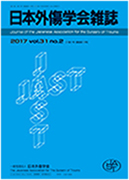Volume 38, Issue 1
Displaying 1-4 of 4 articles from this issue
- |<
- <
- 1
- >
- >|
Clinical Experience
-
Article type: Clinical Experience
2024 Volume 38 Issue 1 Pages 1-7
Published: January 20, 2024
Released on J-STAGE: January 20, 2024
Advance online publication: October 25, 2023Download PDF (2445K)
Case Report
-
Article type: Case Report
2024 Volume 38 Issue 1 Pages 8-13
Published: January 20, 2024
Released on J-STAGE: January 20, 2024
Advance online publication: November 01, 2023Download PDF (2582K) -
Subject area: Case Report
2024 Volume 38 Issue 1 Pages 14-19
Published: January 20, 2024
Released on J-STAGE: January 20, 2024
Advance online publication: November 10, 2023Download PDF (2902K) -
Article type: Case Report
2024 Volume 38 Issue 1 Pages 20-26
Published: January 20, 2024
Released on J-STAGE: January 20, 2024
Advance online publication: December 15, 2023Download PDF (3296K)
- |<
- <
- 1
- >
- >|
